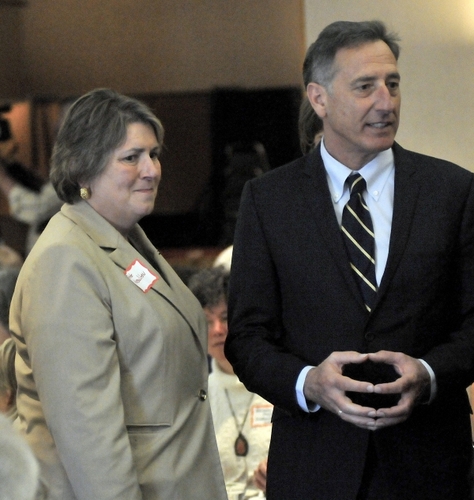BRATTLEBORO — The state has refined application guidelines for the fledgling economic development program designed to help businesses and nonprofits create jobs.
Created last year, the Windham County Economic Development Program looks to help revive the county's economy in the wake of losing high-wage jobs from the closure of the Vermont Yankee nuclear plant.
At a Brattleboro Area Chamber of Commerce luncheon on April 15, Gov. Peter Shumlin made his goals for the program funding clear - jobs, jobs, and more jobs.
“How do we make Vermont's economy work for every Vermonter,” said Shumlin.
Windham County has opportunities to overcome the loss of jobs from the shuttering of VY, Shumlin said, but he admitted that the state did not express its expectations clearly to applicants vying for the WCEDP funds.
After the first round of applications delivered less than what the Governor hoped for, he and Secretary of Commerce Patricia Moulton announced that her department would refine the application before opening the next round.
“I'm pleased we've come up with a process after we put on the brakes,” he said.
Local feedback helped
After receiving feedback from Windham County economic development groups, Shumlin said the application process was simplified.
The emphasis now was to use the program's funds to create jobs where none would have existed without it, Shumlin said.
Moulton stressed that local organizations helped redesign the program. Brattleboro Development Credit Corp., Windham Regional Commission, and the towns of Brattleboro, Bellows Falls, and Wilmington all have participated in providing technical assistance and feedback for the program.
The new and improved guidelines include a few pre-application steps to determine whether a proposed project fits the WCEDP. Applicants must attend an informational workshop before applying. Organizations and businesses will also submit letters of intent.
The state will be “candid with you right from the beginning,” Shumlin said.
Going forward, the Agency of Commerce and Community Development will release a request for proposals listing what type of projects are eligible for grant funding.
The Vermont Economic Development Authority (VEDA) will continue to manage the WCEDP loans. VEDA accepts loan applications on a rolling basis provided businesses have attended the pre-application workshop and written their letters of intent.
Some creative financing is available, said Moulton. In general, loans will have a fixed 2 percent interest rate, with a maximum amount of $350,000.
Other incentive packages are on the table. These packages could include loans, grants and other types of incentives for expanding existing businesses or new businesses that will create jobs.
Moulton said that, ideally, three-quarters of the WCEDP funds will go toward loans and 25 percent into grants.
“We don't know today what will be walking through the door tomorrow and we must be responsive,” said Moulton.
What price innovation?
Shumlin's focus on jobs at the luncheon came with a side of lead balloon.
Abraham Noe-Hays of the Rich Earth Institute asked the governor outright if his organization would receive funding.
Shumlin told Noe-Hays, “Probably not.”
Rich Earth researches and promotes the use of human waste as a potential resource such as fertilizer. The Brattleboro-based nonprofit has been featured in national and international media. The University of Michigan and the University of Buffalo both work with the institute to conduct research.
The institute's application was rejected in the first round of WCEDP funding.
Rep. Tristan Toleno, D-Brattleboro, commented that research and development funding is scarce, and that innovative businesses like Rich Earth require research and development backing to get their projects off the ground.
Shumlin said that while Rich Earth initiatives are a great idea, it is better suited to other existing funding programs,
The Governor said he didn't want to look back at the VY money in 10 years and see it was chewed up by speculative programs.
“Let's use that money for jobs that we know will be boots on the ground,” he said.
Jonathan Morse of the Sustainable Energy Outreach Network (SEON) launched to his feet and said, “I'm not happy with your answer.”
Only innovation will make Windham County a national center of new businesses, he said.
“We're on the cutting edge of making things happen,” said Morse. “Let's have some political courage to make things happen.”
Shumlin didn't back down.
WCEDP monies are for job creation, he said. Other existing funds can pay for innovation.
“These are tough times in many ways, but there are huge opportunities in tough times,” Shumlin said.
